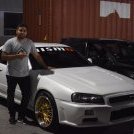Rb20 < Rb25 Turbo Upgrade
Announcements
-
Similar Content
-
Latest Posts
-
By soviet_merlin · Posted
Man, different parts but the same numbers is terrible @dbm7! And it doesn't help that most online shops don't list the part numbers at all. They just give a list of compatible models... -
Slow when hot could also be because its getting more dynamic compression, OR things are getting a bit tighter once it is all expanded. If it were an earthing issue, typically I'd expect you to have it have issues all the time. Unless it's really a combination of both things. Where the higher compression, and things being a bit tighter, is giving that bit of extra load and you do need a slight clean up on the cables/connections.
-
Yeah, this is one of the most annoying things about nissan part numbers... I've got an unrelated example... Image is of the AT output shaft ~ they have the same part#, but clearly the shaft on the left is beefier design to that on the right ...the difference (essentially) is the 'lighter' shaft on the right, is for engines up to RB25DE (this includes RB20 variants) : the shaft on the left is for RB25/26DET(T)....are they interchangeable? Yes...but obviously one shaft is going to be stronger than the other...and, the lighter shaft is around USD115, but the heavier shaft closer to USD150...same part#... ...epc-data usually tells a tale ~ the amayama listing for 39100-23U60 has a note "Longest side is between 60 and 105 cm" ; no such info is there for 39100-23U70 ...and given the great disparity in price between the 2 parts, it makes me at least curious (to the point of caution) where the 'extra money' went? ...ie; these 2 parts have a cost difference that (to myself at least) isn't explained by 'plastic boot'...ie; with amayama there's AUD700 price difference ...plastic versus rubber?...I'm not seeing it like that...and 60cm ~ 105cm...??...that's a huge disparity....something hinky going on here... I'd try searching by VIN, not model... /2cents
-
I don't know for sure, but I'd expect them all to be interchangeable given the diff end and hub end don't move/change between any C34 series. Often Nissan will change part numbers and the aftermarket follows those year ranges; but the original part number change doesn't mean other parts won't fit. The change could be a change in material, internal parts or even just supplier. For example, all the RB gearbox to engine bolts are no longer available and there is a new part number instead. The only change is they went from cadmium plated bolts to zinc plated due to the issues manufacturing with Cadmium. They look different but work the same.
-
By soviet_merlin · Posted
One year is a bit concerning. Did you try contacting GSP? It says 5 year warranty on the box if I remember correctly. I'm also running their driveshafts on my S2 Stagea. You could check the part numbers on Amayama for your year. Here's the link for my 1998 which gives the 39100-23U60 part number. Well, that and 39100-23U70. https://www.amayama.com/en/genuine-catalogs/epc/nissan-japan/stagea/wgnc34/6649-rb25det/trans/391 What does it say for yours?
-






Recommended Posts
Create an account or sign in to comment
You need to be a member in order to leave a comment
Create an account
Sign up for a new account in our community. It's easy!
Register a new accountSign in
Already have an account? Sign in here.
Sign In Now